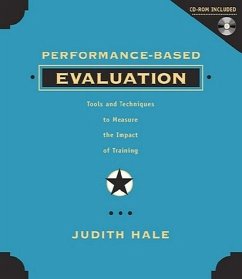If you are an experienced trainer, an instructional designer, a specialist in performance improvement, or a manager responsible for learning and performance, Performance-Based Evaluation . . . offers you the proven tools and information to evaluate programs and people performance. Filled with real-world examples, this practical resource will help you to determine what to do and (just as important) what not to do.
Performance-Based Evaluation contains a wealth of information including:
* Suggestions on how to measure both hard and soft skills
* Guidance on measuring required and mandated programs
* Ideas for measuring elective training and employee relations programs
* Procedures for comparing different delivery systems
* Information on how to sample people and documents
* Tips for both collecting data and information on analyzing data using descriptive and inferential statistics
In addition, the book includes a CD-ROM with customizable and reproducible job aids, charts, and exercises.
List of Exhibits, Tables, and Figures.
CD-ROM Contents.
Preface.
Introduction.
Chapter 1: Evaluation as a Strategy.
The Business Model.
Planning and Strategy.
Customers and Customer Relationships.
Product Portfolio.
Vendors, Contractors, and Off-the-Shelf Programs.
Missteps.
Tips and Techniques.
Summary.
Where to Learn More.
Chapter 2: Why Measure Effectiveness and Efficiency.
Effectiveness and Efficiency.
Missteps.
Tips and Techniques.
Summary.
Where to Learn More.
Note.
Chapter 3: How to Measure Effectiveness.
External Measures.
Missteps.
Tips and Techniques.
Summary.
Where to Learn More.
Chapter 4: How to Measure Efficiency.
Internal Measures.
Cost Drivers.
Formative Evaluation.
How to Find Internal Measures.
Missteps.
Tips and Techniques.
Summary.
Where to Learn More.
Note.
Chapter 5: How to Measure Hard and Soft Skills.
Skills and Requirements.
Hard and Soft Skills.
Performance System.
Domain and Level.
Context.
Variance.
Missteps.
Tips and Techniques.
Summary.
Where to Learn More.
Notes.
Chapter 6: How to Measure Required and Mandated Programs.
Required Training.
Required Training Measures.
Proficiency and the Role of Training.
Mandated Training.
Missteps.
Tips and Techniques.
Summary.
Where to Learn More.
Chapter 7: How to Measure Elective Training and Employee Relations Programs.
Elective Training.
Human Resource Sponsored Programs.
Management Sponsored or Championed Programs.
Programs Based on a Perceived Need.
Measuring Probability of Adoption and Long-Term Change.
Programs That Inform.
Missteps.
Tips and Techniques.
Summary.
Where to Learn More.
Notes.
Chapter 8: How to Evaluate Delivery Alternatives.
The Driver.
The Criteria.
Missteps.
Tips and Techniques.
Summary.
Where to Learn More.
Notes.
Chapter 9: How to Sample People and Documents.
Measurement Plan.
Precision and Cost.
Population and Sampling.
Missteps.
Tips and Techniques.
Summary.
Where to Learn More.
Chapter 10: How to Collect Data.
Interviews.
Group Data-Gathering Processes.
Group Dynamics.
Direct Observations.
Missteps.
Tips and Techniques.
Summary.
Where to Learn More.
Notes.
Chapter 11: How to Analyze Data Using Descriptive Statistics.
Quantitative and Qualitative Data.
Surveys.
Nominal Group Data.
Critical-Incident Questions.
Group Dynamics.
Missteps.
Tips and Techniques.
Summary.
Where to Learn More.
Notes.
Chapter 12: How to Analyze Data Using Inferential Statistics.
Inferential Statistics.
Correlations.
Comparing Results with Expectations.
Pre- and Post-Comparisons.
Missteps.
Tips and Techniques.
Summary.
Where to Learn More.
Notes.
Index.
About the Author.
How to Use the CD-ROM.
Performance-Based Evaluation contains a wealth of information including:
* Suggestions on how to measure both hard and soft skills
* Guidance on measuring required and mandated programs
* Ideas for measuring elective training and employee relations programs
* Procedures for comparing different delivery systems
* Information on how to sample people and documents
* Tips for both collecting data and information on analyzing data using descriptive and inferential statistics
In addition, the book includes a CD-ROM with customizable and reproducible job aids, charts, and exercises.
List of Exhibits, Tables, and Figures.
CD-ROM Contents.
Preface.
Introduction.
Chapter 1: Evaluation as a Strategy.
The Business Model.
Planning and Strategy.
Customers and Customer Relationships.
Product Portfolio.
Vendors, Contractors, and Off-the-Shelf Programs.
Missteps.
Tips and Techniques.
Summary.
Where to Learn More.
Chapter 2: Why Measure Effectiveness and Efficiency.
Effectiveness and Efficiency.
Missteps.
Tips and Techniques.
Summary.
Where to Learn More.
Note.
Chapter 3: How to Measure Effectiveness.
External Measures.
Missteps.
Tips and Techniques.
Summary.
Where to Learn More.
Chapter 4: How to Measure Efficiency.
Internal Measures.
Cost Drivers.
Formative Evaluation.
How to Find Internal Measures.
Missteps.
Tips and Techniques.
Summary.
Where to Learn More.
Note.
Chapter 5: How to Measure Hard and Soft Skills.
Skills and Requirements.
Hard and Soft Skills.
Performance System.
Domain and Level.
Context.
Variance.
Missteps.
Tips and Techniques.
Summary.
Where to Learn More.
Notes.
Chapter 6: How to Measure Required and Mandated Programs.
Required Training.
Required Training Measures.
Proficiency and the Role of Training.
Mandated Training.
Missteps.
Tips and Techniques.
Summary.
Where to Learn More.
Chapter 7: How to Measure Elective Training and Employee Relations Programs.
Elective Training.
Human Resource Sponsored Programs.
Management Sponsored or Championed Programs.
Programs Based on a Perceived Need.
Measuring Probability of Adoption and Long-Term Change.
Programs That Inform.
Missteps.
Tips and Techniques.
Summary.
Where to Learn More.
Notes.
Chapter 8: How to Evaluate Delivery Alternatives.
The Driver.
The Criteria.
Missteps.
Tips and Techniques.
Summary.
Where to Learn More.
Notes.
Chapter 9: How to Sample People and Documents.
Measurement Plan.
Precision and Cost.
Population and Sampling.
Missteps.
Tips and Techniques.
Summary.
Where to Learn More.
Chapter 10: How to Collect Data.
Interviews.
Group Data-Gathering Processes.
Group Dynamics.
Direct Observations.
Missteps.
Tips and Techniques.
Summary.
Where to Learn More.
Notes.
Chapter 11: How to Analyze Data Using Descriptive Statistics.
Quantitative and Qualitative Data.
Surveys.
Nominal Group Data.
Critical-Incident Questions.
Group Dynamics.
Missteps.
Tips and Techniques.
Summary.
Where to Learn More.
Notes.
Chapter 12: How to Analyze Data Using Inferential Statistics.
Inferential Statistics.
Correlations.
Comparing Results with Expectations.
Pre- and Post-Comparisons.
Missteps.
Tips and Techniques.
Summary.
Where to Learn More.
Notes.
Index.
About the Author.
How to Use the CD-ROM.

